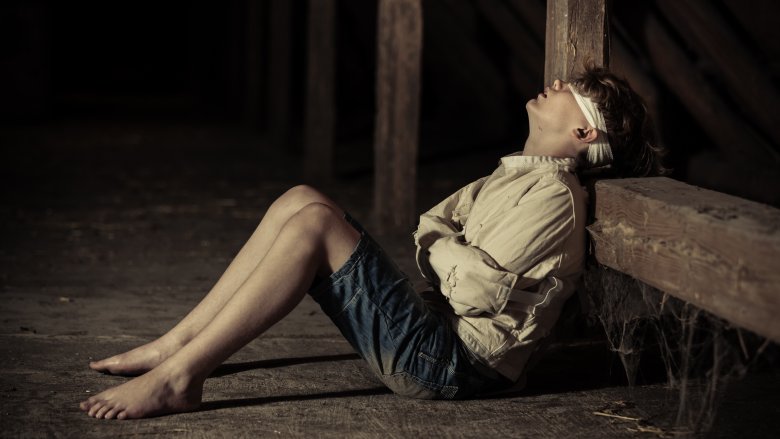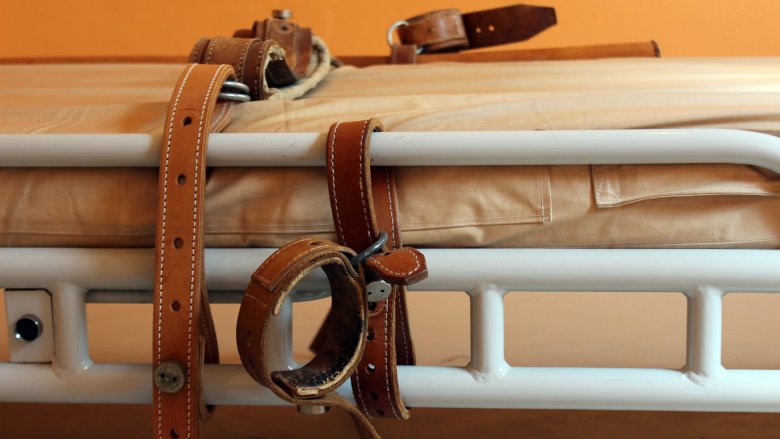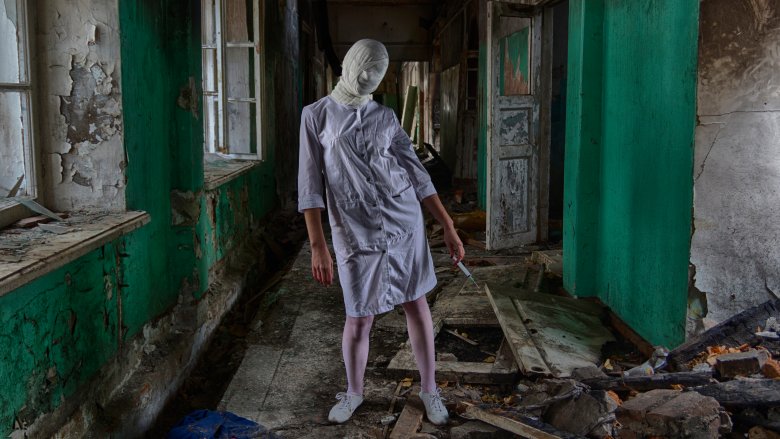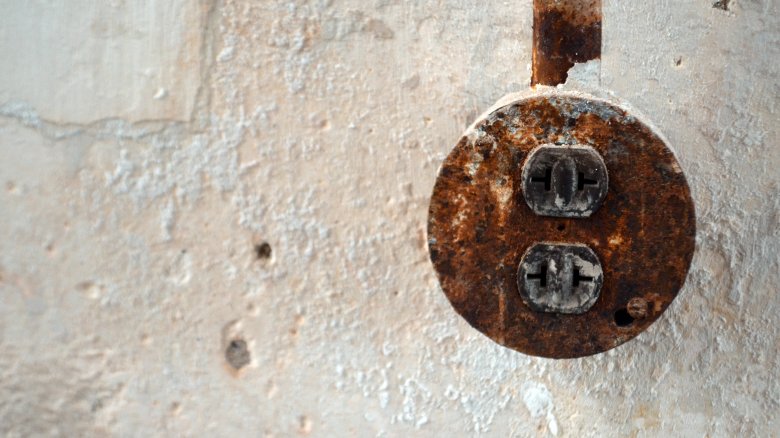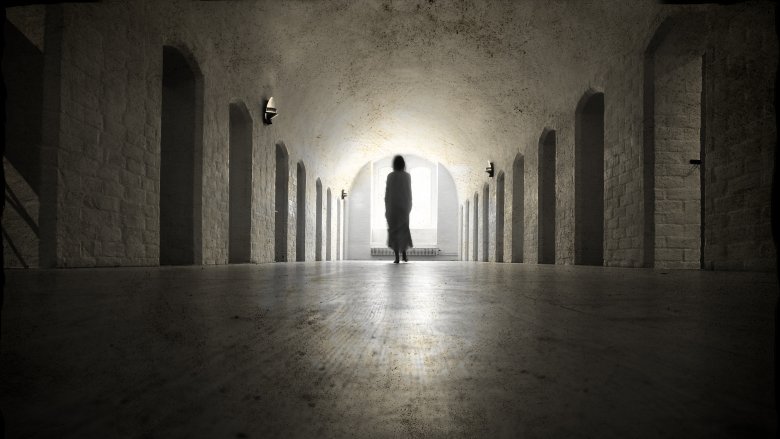What Really Went On Behind Closed Doors At A Victorian-Era Asylum
Mankind has a really long history of being horrible to each other for any and every reason imaginable. Given the fact that the world still isn't great with the acknowledgement and treatment of mental illness in the 21st century, it's no real surprise that the so-called "insane asylums" of the Victorian era were almost unthinkably horrible. Many were dark, dismal places filled with people Nellie Bly called "poor unfortunates" (via Brain Pickings), and when she feigned mental illness to get a first-hand look at what those unfortunates were subjected to, it outraged a nation.
Change didn't happen immediately — far from it. For decades, people struggled in the darkness, lived lonely lives filled with pain, and died as forgotten souls. It's almost impossible to imagine just what went on behind closed doors in these institutions designed to give help and shelter to the most vulnerable section of the population. Too often, they offered not protection, but punishment.
Life in asylums will always be sensationalized for entertainment, but dramatizations will never tell the whole story. Today, we have access to records, letters, and exposés written by real-life former patients. Reading them will ensure their struggles are not forgotten.
Struggles of the perfectly sane
In 1887, journalist Nellie Bly went undercover to spend ten days in an asylum on Blackwell's Island in New York. While she was there, she was witness to — and subjected to — some incredibly inhumane treatment, but she noticed something: others who were suffering the same treatment had no more reason to be committed than she did.
She wrote (via St. MU History) not just of the ice baths and the physical abuse, but of the women who were there for no real reason. One woman she met had been committed only because she spoke French, and the little English she did know wasn't enough to allow her to tell anyone her story. Others were there simply because their families could no longer care for them, and some were there just because they had no other place to go.
Bly wrote (via Medium) that doctors conducting interviews tended to assume something was mentally wrong with the women they were talking to, so they questioned them in such a way that would ultimately confirm the diagnosis. In preparation for her stint in the asylum, Bly had practiced acting in a way that would keep her committed. Once there, though, she found there was no need for it. She wrote (via Psychiatry: The Science of Lies), "Yet strange to say, the more sanely I talked and acted the crazier I was thought to be."
Bread and water
When it came to feeding patients, different asylums had different strategies. There were asylums like Blackwell's, where Bly was served (via Medium) food that was only vaguely food: slightly spoiled meat, broth, tea, and bread she described as "black and dirty... hard, and in places nothing more than dried dough." There were sometimes spiders in the bread, but starving patients still ate hungrily.
Other asylums were a little different. English asylums — like the Buckinghamshire County Asylum — tended to strive for self-sufficiency, and patients grew most of their own food. Historic England says that led to a diet that was much better than most working class people had, and it was filled with fresh vegetables, cheese, bread, fish, meat, and beer.
Then, there were Australian asylums, like the ones inspected by Dr. George Tucker in the 1880s. He described the food as "amply sufficient and sufficiently cooked" (via Museums Victoria), but it was the service that was "demoralizing." Patients took turns — eight at a time — eating at a single table, where they used broken tins, shared three mugs, and ate with dirty utensils. He called for changes, but nothing happened. In 1900, one patient wrote about his three-week stay in Kew, and noted something he found particularly difficult: every cup and plate was labeled "Lunatic Asylum," leading him to make the dismaying observation, "We were never able to get away from the fact that we were lunatics."
Taking air and exercise
Between 1873 and 1908, the Royal Edinburgh Asylum was under the watchful eye of a superintendent named Dr. Thomas Clouston. Clouston believed that strict "discipline, order, [and] a life under medical rule" was the secret to success, and that included getting patients up early and sending them out on walks around the grounds (via The Scotsman).
According to Historic England, taking air and exercise was a regular part of asylum life. Doesn't sound so bad, right? It's just a hike through the English countryside, and time outdoors is good for everyone's mental health... right? Not always.
For those confined at the Norfolk County Asylum, it was more like a military drill, with patients made to march around the 30-acre grounds while responding to orders shouted by staff. Hundreds of patients would be marched around outside, and according to a Lunacy Commission Inspector who oversaw the process, "Great control is gained over the patients, and the task of taking a vast number... for air and exercise becomes comparatively easy."
Writing letters never delivered
It's tough to know what really, truly goes on behind doors closed to the outside world, but fortunately, many of the patients committed to asylum life were not only literate, but wrote extensively on their experiences there. According to The Scotsman, letters — like the hundreds written by the Victorian-era patients at the Royal Edinburgh Asylum — gave a fascinating glimpse into daily life in an asylum.
Patients wrote about their care, their treatment, and oftentimes, they wrote about why they didn't belong there. They wrote about how their families sent them there, they wrote about how they wanted their families to get them out, and they wrote poignant, heartbreaking pleas to those on the outside. And they undoubtedly waited for responses that never came, not because their friends and family had ceased to care, but because their letters never got delivered. Letters were intercepted and read by asylum staff, and any found to be in any way inappropriate for reading outside asylum walls were kept and stored in an archive, all without patients knowing that their messages never reached the intended recipients.
Alcohol for health, alcohol for sedatives
Beer was an almost shockingly important part of asylum life, and Niall McCrae of the Institute of Psychiatry, London, says that asylum staff even had part of their wages paid in beer. British asylums gave their patients a daily ration of beer, with extra rations given to those who worked on the asylum grounds in some capacity. Most asylums even had their own brewhouses, and they tended to make light beer for daily drinking, and extra beer and cider were served to patient workers when it was time to harvest the summer's crops. The practice fell out of fashion when the temperance movement kicked into high gear, but alcohol wasn't just for daily diets and rewarding work well done.
It was medicinal, too. Alcohol in the Victorian era was prescribed for all kinds of things, and asylums used it — particularly stout and brandy — as part of a prescription for those diagnosed as melancholic. According to archival documents saved by St. Joseph's Regional Mental Health Care London (Ontario), medicinal alcohol and spirits were a regular part of the budget. In 1874, they spent a reported $1,850 on "spirits, wine, and beer," and when that number is adjusted for inflation, it's a whopping $40,700 in today's money. It was commonly used as a sedative, but when attitudes began to shift, many patients were being taken off alcohol instead of being encouraged to use it.
Sitting, sitting, and more sitting
When Nellie Bly put herself in the shoes of an asylum patient, she found that part of their daily routine was sitting. Not reading, not talking, not being occupied by any leisurely activity that might be a bit of fun. Just sitting on hard, straight-backed benches.
"I was never so tired as I grew sitting on those benches," she wrote (via Medium). "Several of the patients would sit on one foot or sideways to make a change, but they were always reproved and told to sit straight up. If they talked they were scolded and told to shut up... What, excepting torture, would produce insanity quicker than this treatment?"
Bly found very quickly that they were expected to sit for at least a few hours every day, usually after doing a round of cleaning that included every part of the asylum, including the nurses' private bedrooms. She predicted that if a patient didn't have physical or mental problems when they entered, "Two months would make her a mental and physical wreck".
Restraints as a solution to nearly everything
Archival documents saved by St. Joseph's Regional Mental Health Care London (Ontario) tell of the terrifying and widespread use of restraints, including everything from cuffs and straps to leather mitts and straightjackets. Patients were restrained if staff thought they were violent and a danger to themselves or others, but they were also restrained for other things. Anyone refusing to eat would be restrained and force-fed with a feeding tube, because — somewhat ironically — nutrition was seen as a major part of so-called "moral therapy." Restraints were also used on patients who injured themselves, particularly during recovery if they showed a tendency to tear at their own bandages.
Sometimes, cuffs and mitts weren't enough, and in those extreme cases, crib beds were used. Those are exactly what they sound like — beds with bars on them, which confined patients with the help of still more restraints.
By the 1880s, restraint use (in the London Asylum for the Insane, at least) had been all but phased out — officially, at least, though patient files across the system indicate they were used for a long time after they were supposedly forbidden.
The chloroform deaths and the broken rib scandal
Not everyone on the outside turned a blind eye to the abuse that was going on inside asylums, and in the 1870s, the medical press started looking into what they thought was a disturbing pattern. A startling number of people were dying in asylums, and many had one thing in common: broken bones, and broken ribs in particular.
Investigating the Body in the Victorian Asylum says the most damning evidence of abuse came when former patients started writing letters to the powers that be, and many told a similar story of attendants who would kneel on unruly patients until they got complete and total submission. The trend was so widespread that in 1887, a jury suggested that all cases involving patients dying with broken ribs should be eligible for charges of manslaughter.
It wasn't the only deadly trend that was seen in Victorian-era asylums, either. Chloroform had been used as an anesthetic beginning in 1847 (via History), but there were huge risks that went along with it. The first officially documented chloroform fatality happened just the next year, and it became so common throughout the 1850s that the trend was simply known as "the chloroform deaths."
Asylum attendants gone bad
When the outside world started looking at what was really happening to the people confined in asylums, they found that the attendants were a huge part of the problem. Not all were bad — some were struggling to care for patients in a violent, overcrowded environment and still trying to do their best — but there were plenty of horribly sadistic stories told about others.
Investigating the Body in the Victorian Asylum says that attendants — the non-medical staff responsible for everyday care — tended to be "uneducated, intemperate, and untrustworthy." The job was hard, after all, and had a high turnover rate. Asylums had trouble retaining staff, and took those they could get. Case files and accounts tell stories of attendants who regularly stole from patients, and there are even accounts of attendants who gave patients weapons and encouraged them to fight amongst themselves.
Novelist Charles Reade wrote Hard Cash in 1863, and even though the character he committed to an asylum was fictional, the research he did wasn't. Former patients vouched for the reality of Reade's story, in which the attendants prone to violence were extremely good at what they did. They knew exactly how to hit to cause the maximum amount of pain without leaving visible bruises.
Regular electroshock therapy sessions
In 2018, the BBC investigated how electroconvulsive therapy actually had benefits for some people, particularly those suffering from depression, mania, and catatonia. But there's a stigma attached to it, and it's really no wonder. Electroshock therapies have been used for a long time, centuries before we really knew what kind of good — or damage — it could do.
According to an article in The British Journal of Psychiatry, countless 19th century asylum doctors were so impressed by the use of electricity as treatment that they jumped at the chance to include it in their arsenal. Patients were prescribed sessions of shock therapy that lasted 10 to 20 minutes, conducted every day or every other day. The electric shock was often constant, and while early techniques involved stimulating the skin by putting electrodes on the hands, it got worse. Gradually, the electrodes were moved to the head, and in 1873 doctors at the Sussex Asylum reported the effects of the treatment were even greater when the patient sat with their hands and feet in water.
These treatments could last for weeks or even months, and case files indicate doctors saw a fair amount of success in patients diagnosed with melancholia. That actually seems to fall in line with 21st century research, so there may have been a kernel of truth to the thinking... not that it makes the methods of application any less horrifying.
Jobs assigned by gender
In many Victorian-era asylums, work was considered a valuable part of therapy. It gave patients a purpose and helped keep them out of trouble. When it came time to assign jobs, it was done on the basis of gender.
Women were tasked with sewing, cooking, and cleaning. When John Connolly wrote a manual on asylum reform, he wrote that women should be kept busy with chores that appealed to their domesticity and femininity, saying (via The University of Bristol) they would thrive if they were allowed to stay "busy and cheerful in a scrupulously clean kitchen." Laundry was considered particularly good therapy, because of the sheer physical exertion required.
Men, on the other hand, were generally sent to work on the grounds, toil on the farms, and taught things like tailoring and upholstery. According to Historic England, most British asylums also had breweries, gasworks, bookbinders, and craft workshops that were overseen by local tradesmen and often employed patients.
While some jobs might have given patients a sense of normalcy and purpose, others definitely didn't. Some asylums were clearly exploiting cheap labor and selling goods to make a profit, and other patients were treated even worse. Some were given completely pointless tasks, employed in activities like sorting a pile of beans by color. The beans would be dumped back together at the end of the day, and the mindless, pointless sorting would begin all over again.
It wasn't all bad for everyone
Victorian-era asylums tend to be painted with a wide, sweeping brush that casts the entire system into darkness. While that's certainly deserved in many ways, it's also important to note that not everyone suffered there.
When The Scotsman looked at hundreds of letters written by patients at the Royal Edinburgh Asylum, they found there were a number of people who spoke about how they were excited to be learning a trade, how the staff made sure there were regularly scheduled dances and entertainments, and how many were eating well for the first time in their lives.
Then, there were people like George Longmore. He spent some time in the Broadmoor Criminal Lunatic Asylum, and in 1884, he re-admitted himself after four years of freedom. He wrote to his family (via Activist History) that he was terribly sorry, but that he had found comfort and safety within the asylum walls. Letters like his suggest that asylum living wasn't all bad for every patient, and that some actually found a place and a community they felt comfortable belonging to. While historians and psychologists as a whole agree that the treatment methods of the Victorian era failed and that the confinement was inhumane, degrading, and dirty, it's just as undeniable that for some people who found themselves there, it was better than the outside world.

